Coursework on Procurement and Contractual Law, EG7016, Semester 1
VerifiedAdded on 2023/02/01
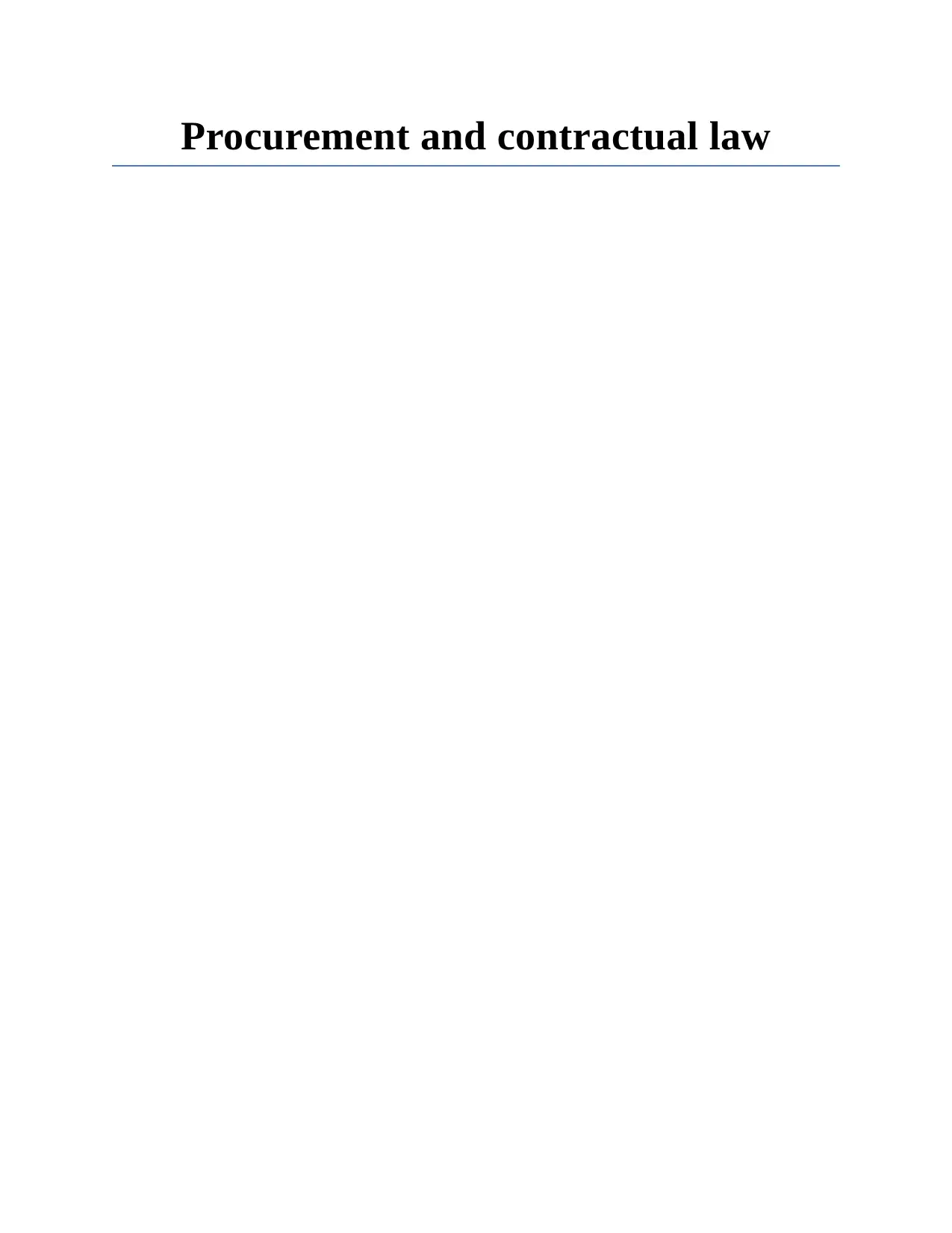
Paraphrase This Document
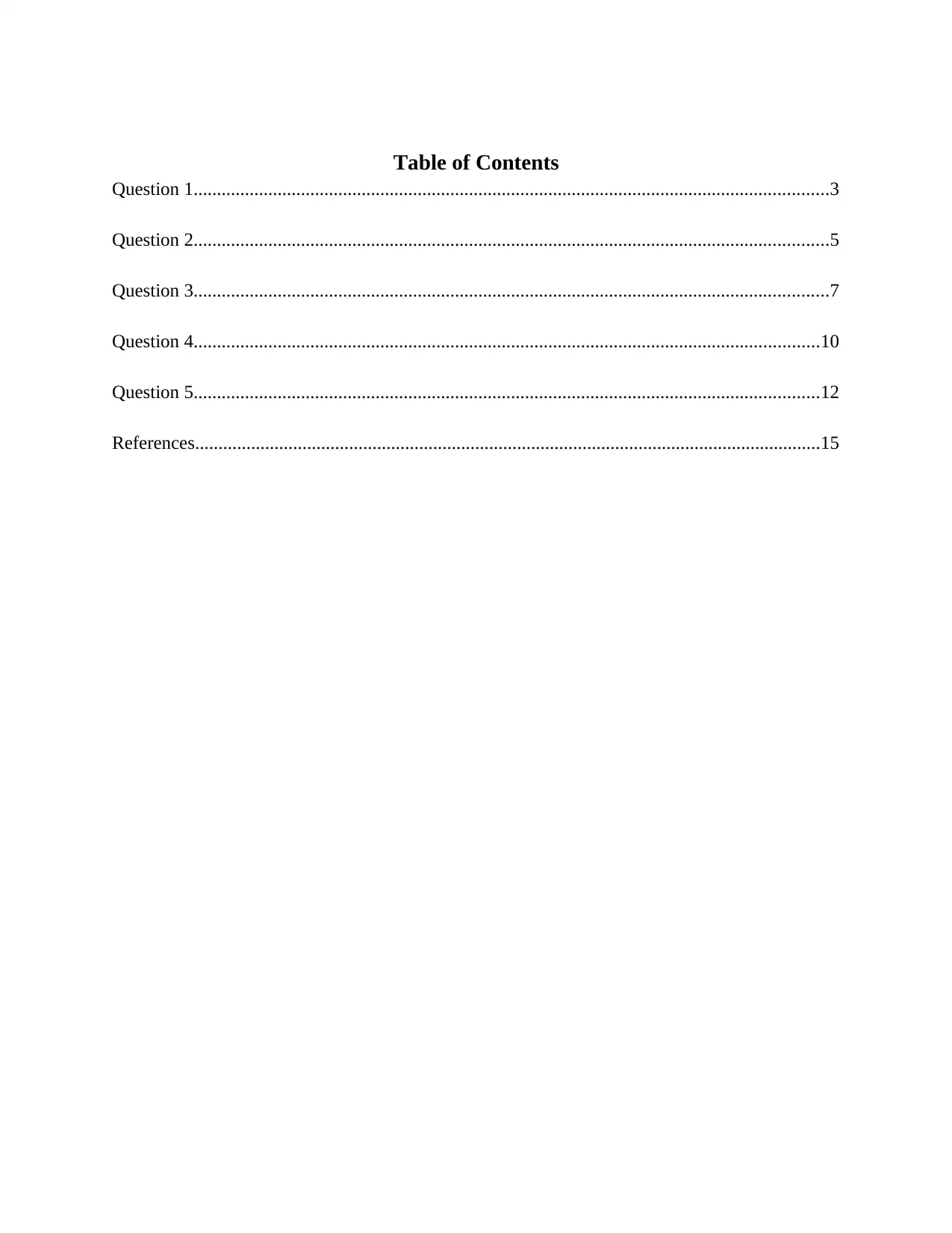
Question 1........................................................................................................................................3
Question 2........................................................................................................................................5
Question 3........................................................................................................................................7
Question 4......................................................................................................................................10
Question 5......................................................................................................................................12
References......................................................................................................................................15
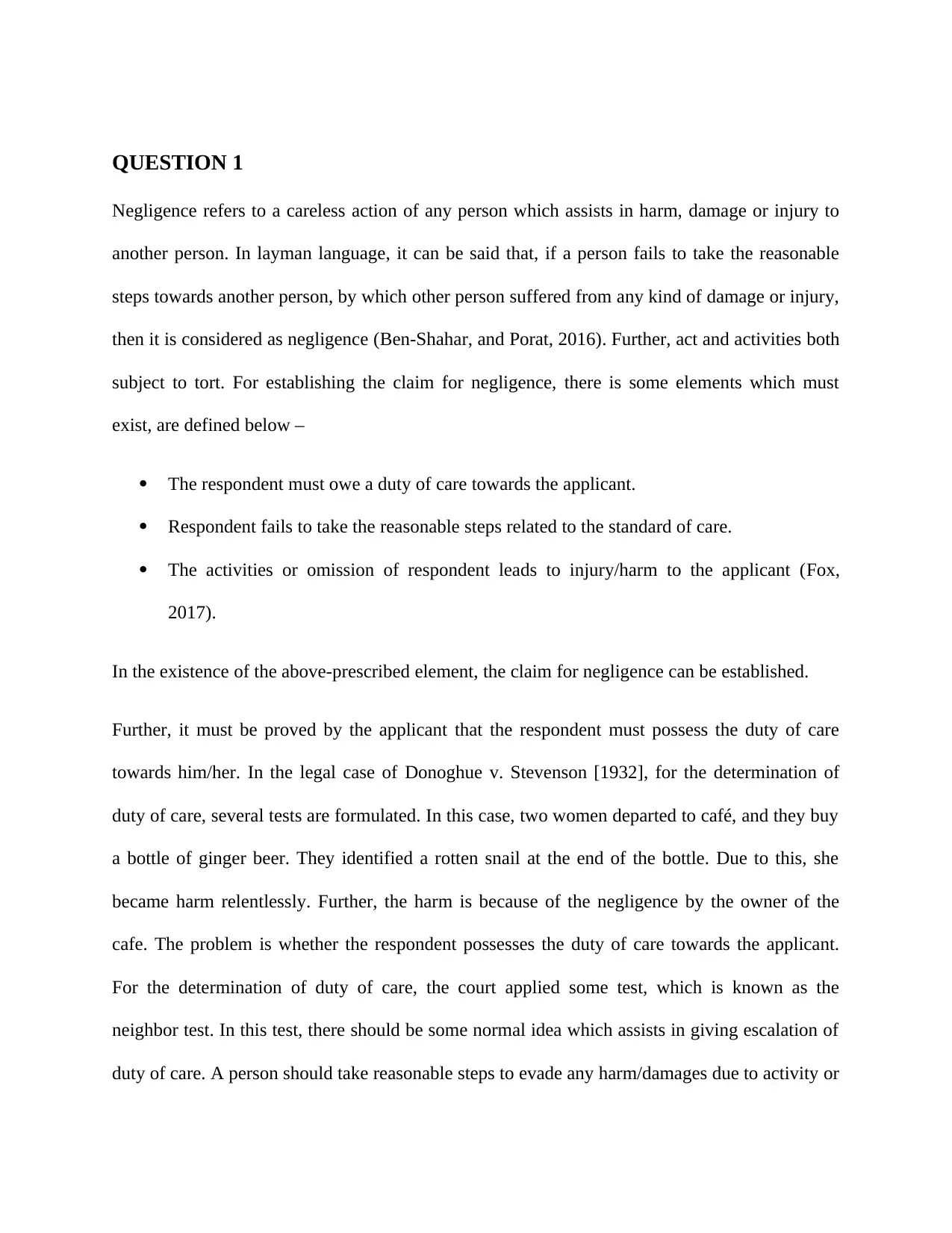
Negligence refers to a careless action of any person which assists in harm, damage or injury to
another person. In layman language, it can be said that, if a person fails to take the reasonable
steps towards another person, by which other person suffered from any kind of damage or injury,
then it is considered as negligence (Ben-Shahar, and Porat, 2016). Further, act and activities both
subject to tort. For establishing the claim for negligence, there is some elements which must
exist, are defined below –
The respondent must owe a duty of care towards the applicant.
Respondent fails to take the reasonable steps related to the standard of care.
The activities or omission of respondent leads to injury/harm to the applicant (Fox,
2017).
In the existence of the above-prescribed element, the claim for negligence can be established.
Further, it must be proved by the applicant that the respondent must possess the duty of care
towards him/her. In the legal case of Donoghue v. Stevenson [1932], for the determination of
duty of care, several tests are formulated. In this case, two women departed to café, and they buy
a bottle of ginger beer. They identified a rotten snail at the end of the bottle. Due to this, she
became harm relentlessly. Further, the harm is because of the negligence by the owner of the
cafe. The problem is whether the respondent possesses the duty of care towards the applicant.
For the determination of duty of care, the court applied some test, which is known as the
neighbor test. In this test, there should be some normal idea which assists in giving escalation of
duty of care. A person should take reasonable steps to evade any harm/damages due to activity or
⊘ This is a preview!⊘
Do you want full access?
Subscribe today to unlock all pages.

Trusted by 1+ million students worldwide
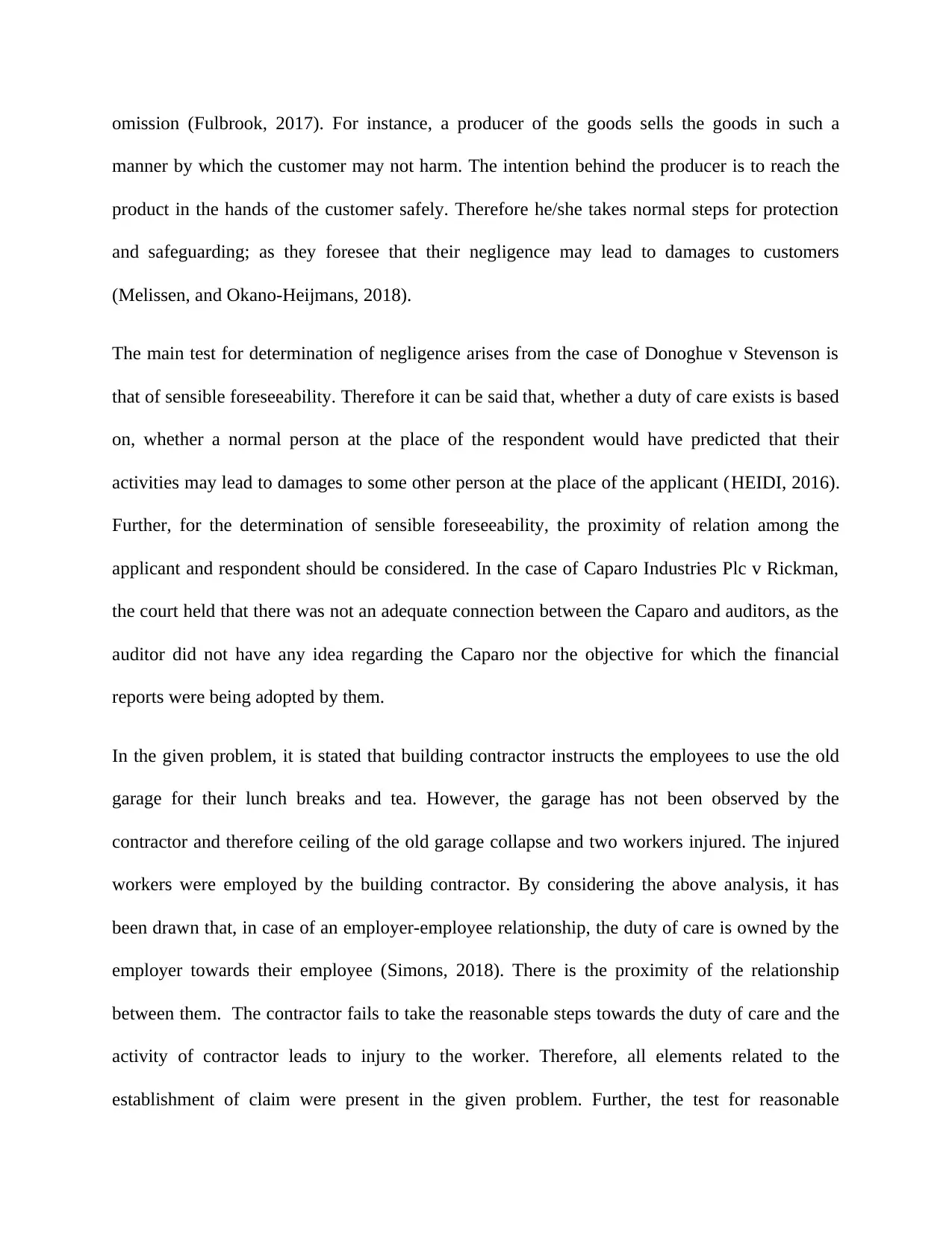
manner by which the customer may not harm. The intention behind the producer is to reach the
product in the hands of the customer safely. Therefore he/she takes normal steps for protection
and safeguarding; as they foresee that their negligence may lead to damages to customers
(Melissen, and Okano-Heijmans, 2018).
The main test for determination of negligence arises from the case of Donoghue v Stevenson is
that of sensible foreseeability. Therefore it can be said that, whether a duty of care exists is based
on, whether a normal person at the place of the respondent would have predicted that their
activities may lead to damages to some other person at the place of the applicant (HEIDI, 2016).
Further, for the determination of sensible foreseeability, the proximity of relation among the
applicant and respondent should be considered. In the case of Caparo Industries Plc v Rickman,
the court held that there was not an adequate connection between the Caparo and auditors, as the
auditor did not have any idea regarding the Caparo nor the objective for which the financial
reports were being adopted by them.
In the given problem, it is stated that building contractor instructs the employees to use the old
garage for their lunch breaks and tea. However, the garage has not been observed by the
contractor and therefore ceiling of the old garage collapse and two workers injured. The injured
workers were employed by the building contractor. By considering the above analysis, it has
been drawn that, in case of an employer-employee relationship, the duty of care is owned by the
employer towards their employee (Simons, 2018). There is the proximity of the relationship
between them. The contractor fails to take the reasonable steps towards the duty of care and the
activity of contractor leads to injury to the worker. Therefore, all elements related to the
establishment of claim were present in the given problem. Further, the test for reasonable
Paraphrase This Document
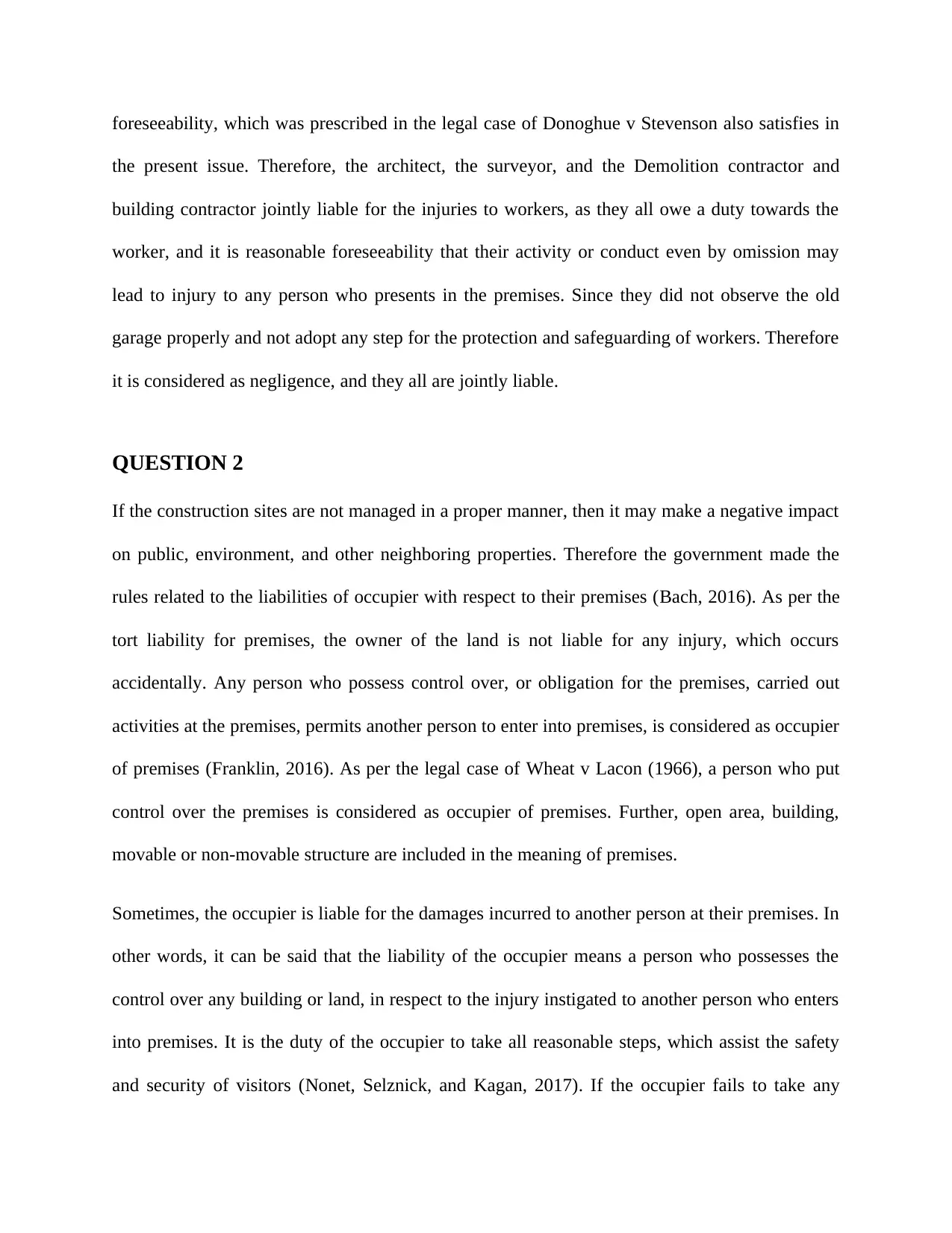
the present issue. Therefore, the architect, the surveyor, and the Demolition contractor and
building contractor jointly liable for the injuries to workers, as they all owe a duty towards the
worker, and it is reasonable foreseeability that their activity or conduct even by omission may
lead to injury to any person who presents in the premises. Since they did not observe the old
garage properly and not adopt any step for the protection and safeguarding of workers. Therefore
it is considered as negligence, and they all are jointly liable.
QUESTION 2
If the construction sites are not managed in a proper manner, then it may make a negative impact
on public, environment, and other neighboring properties. Therefore the government made the
rules related to the liabilities of occupier with respect to their premises (Bach, 2016). As per the
tort liability for premises, the owner of the land is not liable for any injury, which occurs
accidentally. Any person who possess control over, or obligation for the premises, carried out
activities at the premises, permits another person to enter into premises, is considered as occupier
of premises (Franklin, 2016). As per the legal case of Wheat v Lacon (1966), a person who put
control over the premises is considered as occupier of premises. Further, open area, building,
movable or non-movable structure are included in the meaning of premises.
Sometimes, the occupier is liable for the damages incurred to another person at their premises. In
other words, it can be said that the liability of the occupier means a person who possesses the
control over any building or land, in respect to the injury instigated to another person who enters
into premises. It is the duty of the occupier to take all reasonable steps, which assist the safety
and security of visitors (Nonet, Selznick, and Kagan, 2017). If the occupier fails to take any
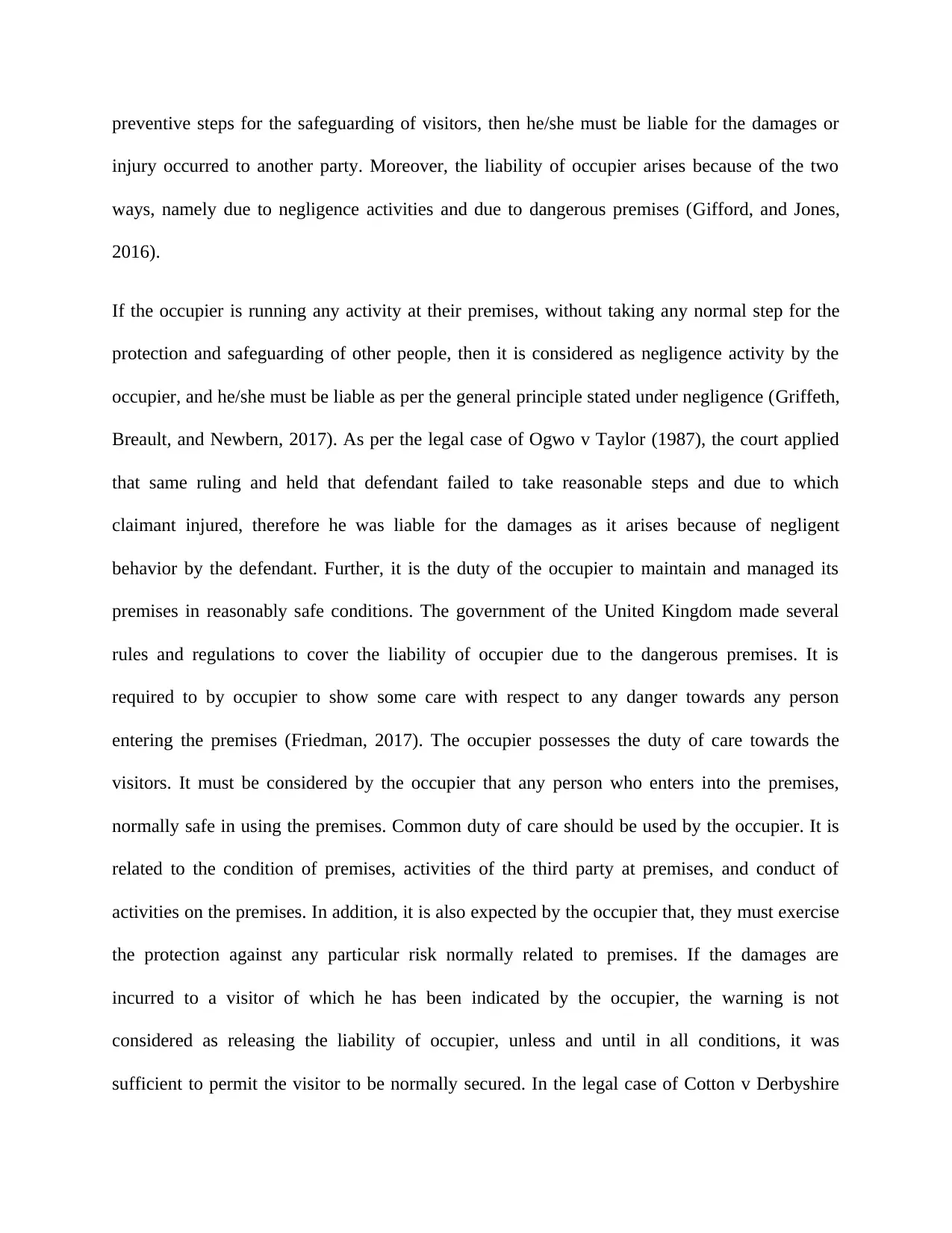
injury occurred to another party. Moreover, the liability of occupier arises because of the two
ways, namely due to negligence activities and due to dangerous premises (Gifford, and Jones,
2016).
If the occupier is running any activity at their premises, without taking any normal step for the
protection and safeguarding of other people, then it is considered as negligence activity by the
occupier, and he/she must be liable as per the general principle stated under negligence (Griffeth,
Breault, and Newbern, 2017). As per the legal case of Ogwo v Taylor (1987), the court applied
that same ruling and held that defendant failed to take reasonable steps and due to which
claimant injured, therefore he was liable for the damages as it arises because of negligent
behavior by the defendant. Further, it is the duty of the occupier to maintain and managed its
premises in reasonably safe conditions. The government of the United Kingdom made several
rules and regulations to cover the liability of occupier due to the dangerous premises. It is
required to by occupier to show some care with respect to any danger towards any person
entering the premises (Friedman, 2017). The occupier possesses the duty of care towards the
visitors. It must be considered by the occupier that any person who enters into the premises,
normally safe in using the premises. Common duty of care should be used by the occupier. It is
related to the condition of premises, activities of the third party at premises, and conduct of
activities on the premises. In addition, it is also expected by the occupier that, they must exercise
the protection against any particular risk normally related to premises. If the damages are
incurred to a visitor of which he has been indicated by the occupier, the warning is not
considered as releasing the liability of occupier, unless and until in all conditions, it was
sufficient to permit the visitor to be normally secured. In the legal case of Cotton v Derbyshire
⊘ This is a preview!⊘
Do you want full access?
Subscribe today to unlock all pages.

Trusted by 1+ million students worldwide
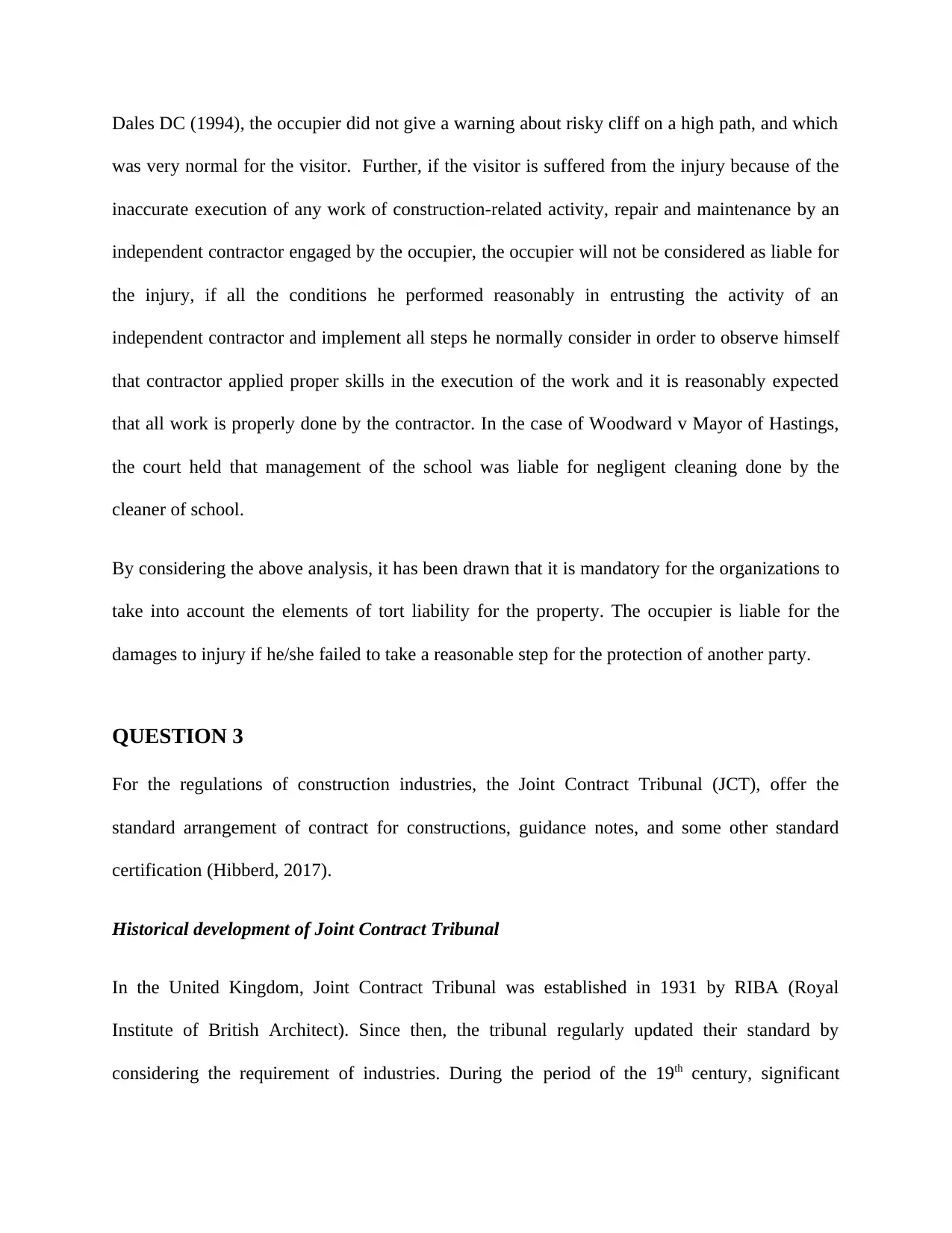
was very normal for the visitor. Further, if the visitor is suffered from the injury because of the
inaccurate execution of any work of construction-related activity, repair and maintenance by an
independent contractor engaged by the occupier, the occupier will not be considered as liable for
the injury, if all the conditions he performed reasonably in entrusting the activity of an
independent contractor and implement all steps he normally consider in order to observe himself
that contractor applied proper skills in the execution of the work and it is reasonably expected
that all work is properly done by the contractor. In the case of Woodward v Mayor of Hastings,
the court held that management of the school was liable for negligent cleaning done by the
cleaner of school.
By considering the above analysis, it has been drawn that it is mandatory for the organizations to
take into account the elements of tort liability for the property. The occupier is liable for the
damages to injury if he/she failed to take a reasonable step for the protection of another party.
QUESTION 3
For the regulations of construction industries, the Joint Contract Tribunal (JCT), offer the
standard arrangement of contract for constructions, guidance notes, and some other standard
certification (Hibberd, 2017).
Historical development of Joint Contract Tribunal
In the United Kingdom, Joint Contract Tribunal was established in 1931 by RIBA (Royal
Institute of British Architect). Since then, the tribunal regularly updated their standard by
considering the requirement of industries. During the period of the 19th century, significant
Paraphrase This Document
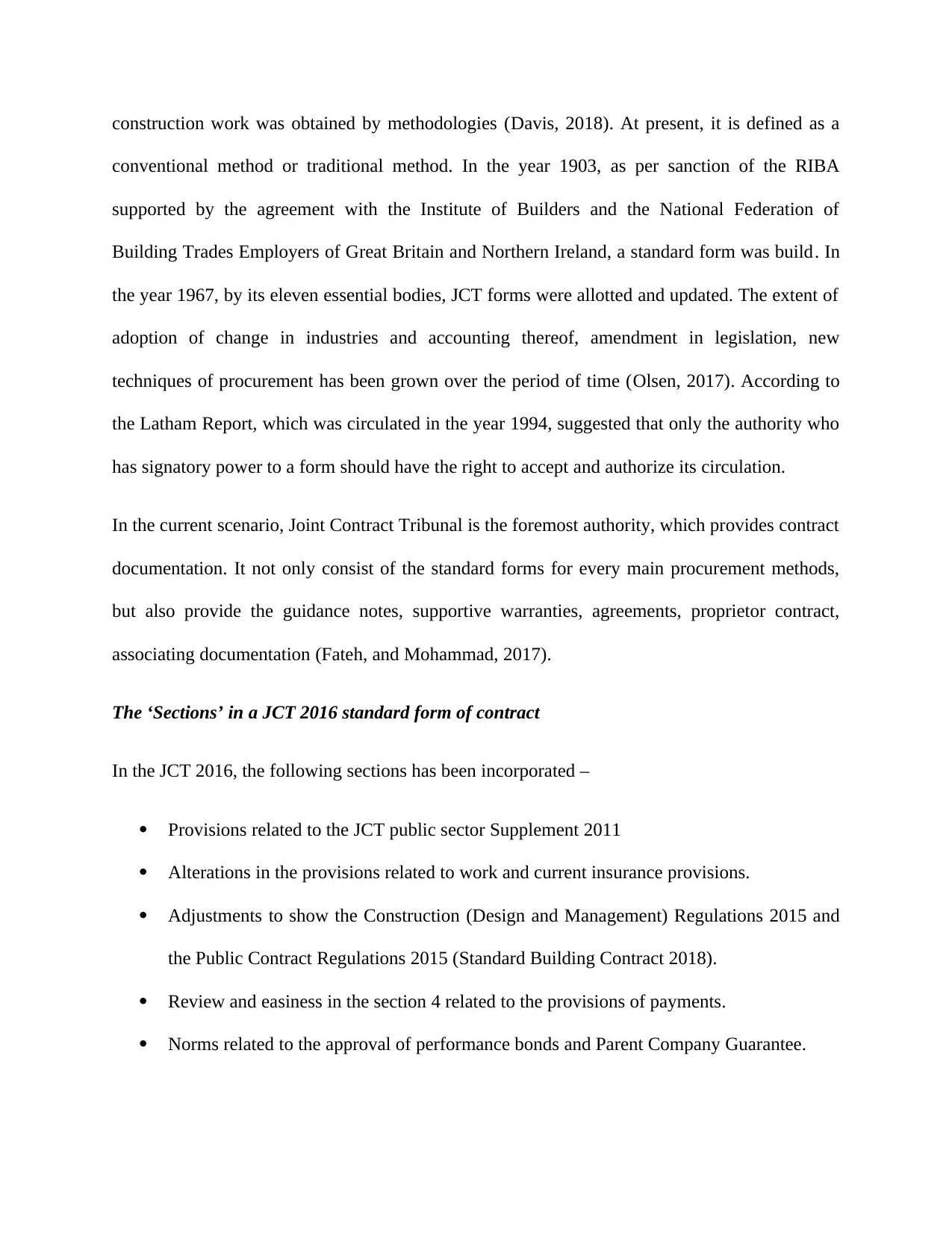
conventional method or traditional method. In the year 1903, as per sanction of the RIBA
supported by the agreement with the Institute of Builders and the National Federation of
Building Trades Employers of Great Britain and Northern Ireland, a standard form was build. In
the year 1967, by its eleven essential bodies, JCT forms were allotted and updated. The extent of
adoption of change in industries and accounting thereof, amendment in legislation, new
techniques of procurement has been grown over the period of time (Olsen, 2017). According to
the Latham Report, which was circulated in the year 1994, suggested that only the authority who
has signatory power to a form should have the right to accept and authorize its circulation.
In the current scenario, Joint Contract Tribunal is the foremost authority, which provides contract
documentation. It not only consist of the standard forms for every main procurement methods,
but also provide the guidance notes, supportive warranties, agreements, proprietor contract,
associating documentation (Fateh, and Mohammad, 2017).
The ‘Sections’ in a JCT 2016 standard form of contract
In the JCT 2016, the following sections has been incorporated –
Provisions related to the JCT public sector Supplement 2011
Alterations in the provisions related to work and current insurance provisions.
Adjustments to show the Construction (Design and Management) Regulations 2015 and
the Public Contract Regulations 2015 (Standard Building Contract 2018).
Review and easiness in the section 4 related to the provisions of payments.
Norms related to the approval of performance bonds and Parent Company Guarantee.

2017).
Further, the following documents that has been incorporated in JCT 2016 –
Standard Building Contract Guide (SBC/G).
Standard Building Contract with Approximate Quantities (SBC/AQ) Tracked
Change Document.
Standard Building Contract with Approximate Quantities (SBC/AQ).
Standard Building Contract with Quantities (SBC/Q) Tracked Change Document.
Standard Building Contract with Quantities (SBC/Q).
Standard Building Contract without Quantities (SBC/XQ) Tracked Change Document.
Standard Building Contract without Quantities (SBC/XQ).
Standard Building Sub-Contract Conditions (SBCSub/C).
Standard Building Sub-Contract Agreement (SBCSub/A).
Standard Building Sub-Contract Guide (SBCSub/G).
Standard Building Sub-Contract with sub-contractor’s design Agreement (SBCSub/D/A).
Standard Building Sub-Contract with sub-contractor’s design Conditions (SBCSub/D/C).
Multi-tiered Dispute Resolution Mechanisms
The multi-tiered disputes resolution mechanism provides various different stages for addressing
the conflicts. It requires the party to attempt the settlement by the discussions, negotiations, or
facilitation, before availing the litigation procedures. If the adequate facts are identified by the
parties related to the specific procedure, then as per this clause it is considered as condition guide
⊘ This is a preview!⊘
Do you want full access?
Subscribe today to unlock all pages.

Trusted by 1+ million students worldwide
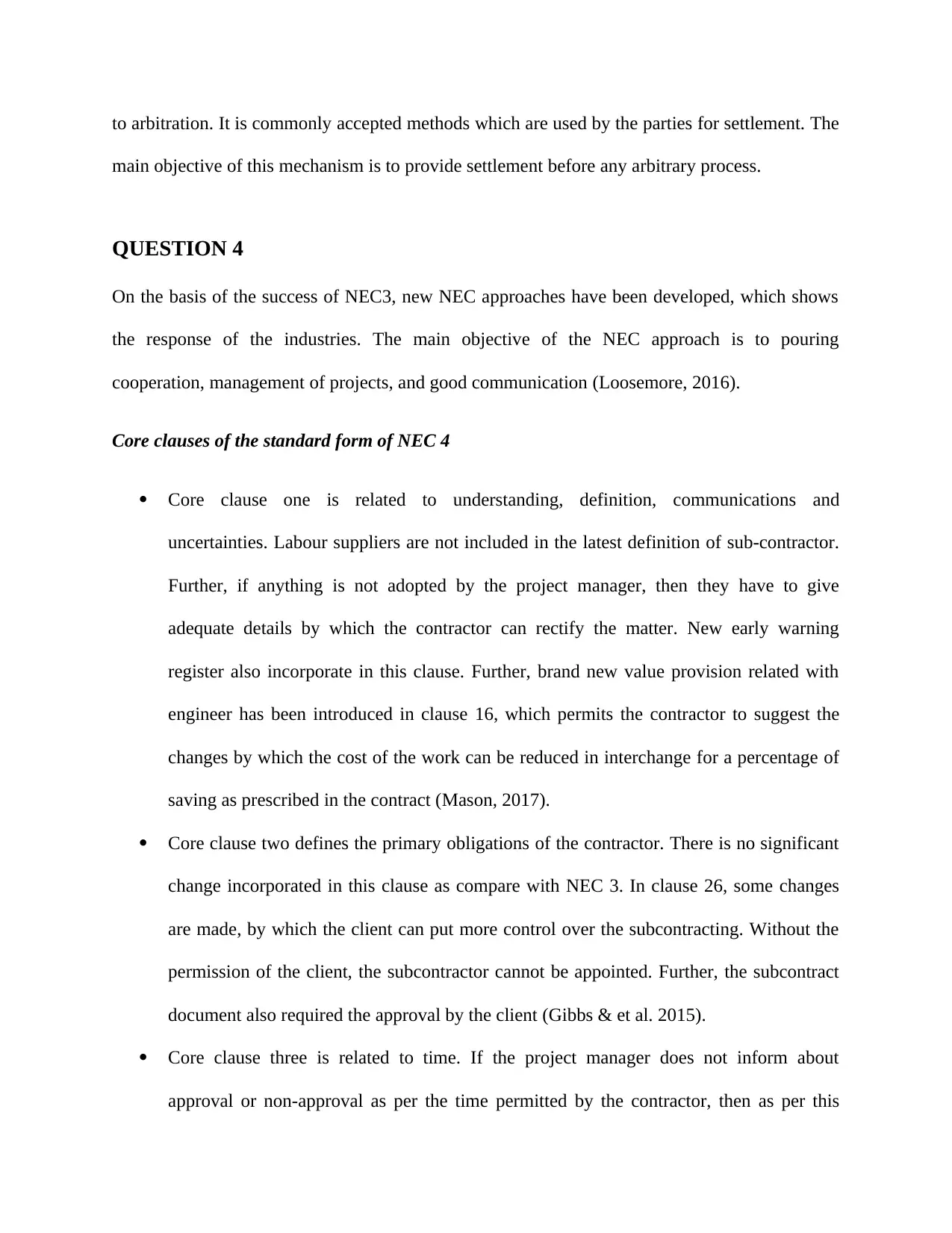
main objective of this mechanism is to provide settlement before any arbitrary process.
QUESTION 4
On the basis of the success of NEC3, new NEC approaches have been developed, which shows
the response of the industries. The main objective of the NEC approach is to pouring
cooperation, management of projects, and good communication (Loosemore, 2016).
Core clauses of the standard form of NEC 4
Core clause one is related to understanding, definition, communications and
uncertainties. Labour suppliers are not included in the latest definition of sub-contractor.
Further, if anything is not adopted by the project manager, then they have to give
adequate details by which the contractor can rectify the matter. New early warning
register also incorporate in this clause. Further, brand new value provision related with
engineer has been introduced in clause 16, which permits the contractor to suggest the
changes by which the cost of the work can be reduced in interchange for a percentage of
saving as prescribed in the contract (Mason, 2017).
Core clause two defines the primary obligations of the contractor. There is no significant
change incorporated in this clause as compare with NEC 3. In clause 26, some changes
are made, by which the client can put more control over the subcontracting. Without the
permission of the client, the subcontractor cannot be appointed. Further, the subcontract
document also required the approval by the client (Gibbs & et al. 2015).
Core clause three is related to time. If the project manager does not inform about
approval or non-approval as per the time permitted by the contractor, then as per this
Paraphrase This Document
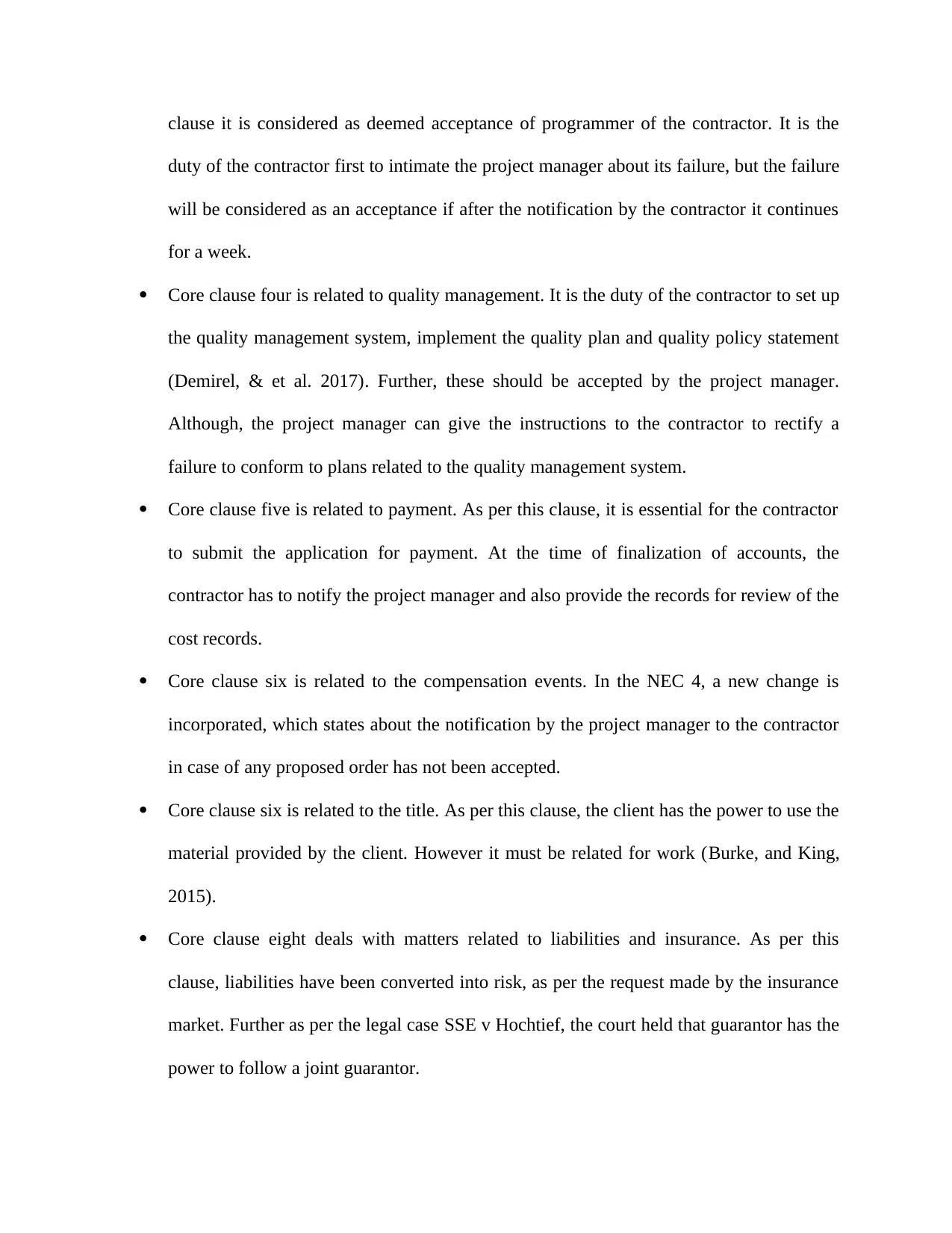
duty of the contractor first to intimate the project manager about its failure, but the failure
will be considered as an acceptance if after the notification by the contractor it continues
for a week.
Core clause four is related to quality management. It is the duty of the contractor to set up
the quality management system, implement the quality plan and quality policy statement
(Demirel, & et al. 2017). Further, these should be accepted by the project manager.
Although, the project manager can give the instructions to the contractor to rectify a
failure to conform to plans related to the quality management system.
Core clause five is related to payment. As per this clause, it is essential for the contractor
to submit the application for payment. At the time of finalization of accounts, the
contractor has to notify the project manager and also provide the records for review of the
cost records.
Core clause six is related to the compensation events. In the NEC 4, a new change is
incorporated, which states about the notification by the project manager to the contractor
in case of any proposed order has not been accepted.
Core clause six is related to the title. As per this clause, the client has the power to use the
material provided by the client. However it must be related for work (Burke, and King,
2015).
Core clause eight deals with matters related to liabilities and insurance. As per this
clause, liabilities have been converted into risk, as per the request made by the insurance
market. Further as per the legal case SSE v Hochtief, the court held that guarantor has the
power to follow a joint guarantor.
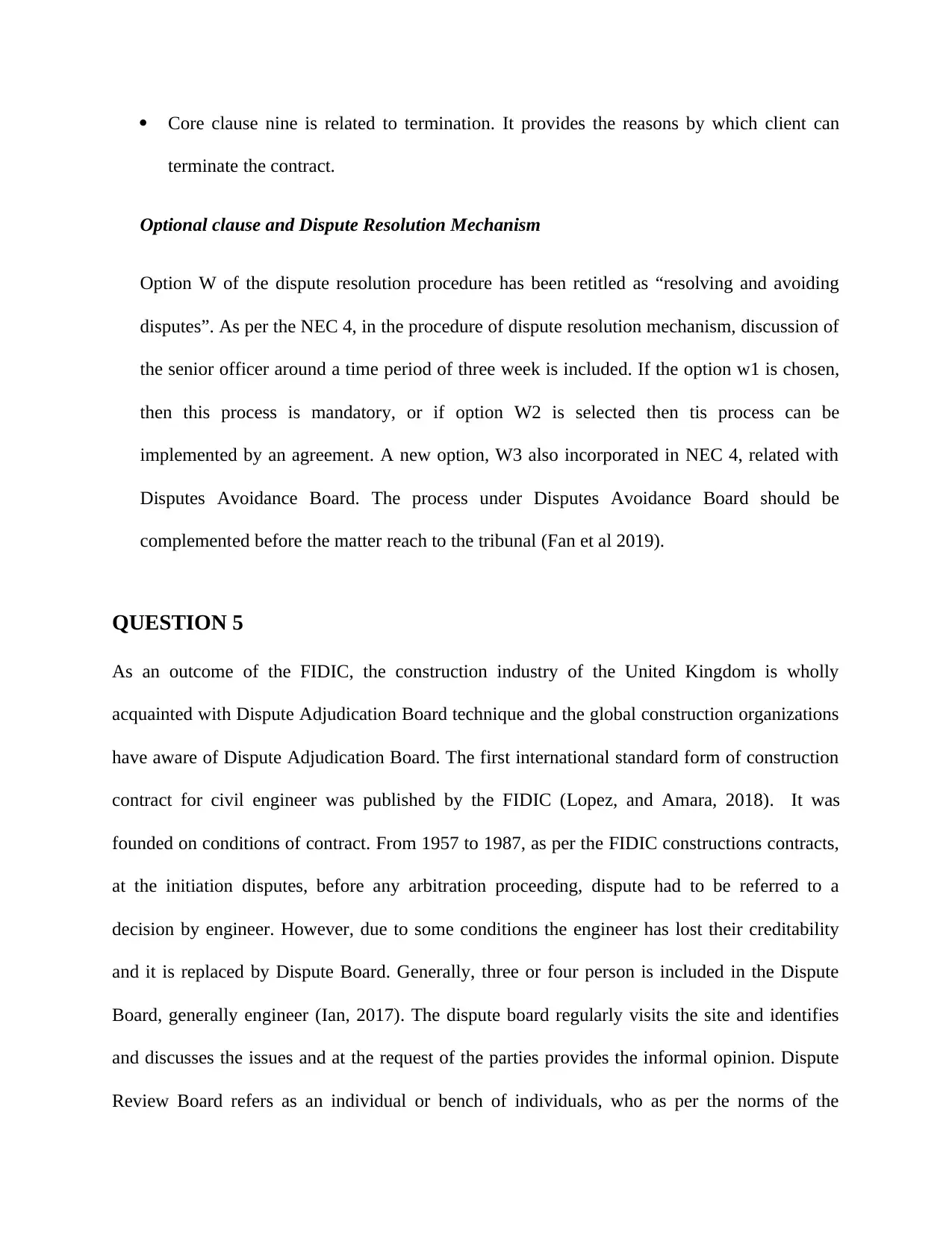
terminate the contract.
Optional clause and Dispute Resolution Mechanism
Option W of the dispute resolution procedure has been retitled as “resolving and avoiding
disputes”. As per the NEC 4, in the procedure of dispute resolution mechanism, discussion of
the senior officer around a time period of three week is included. If the option w1 is chosen,
then this process is mandatory, or if option W2 is selected then tis process can be
implemented by an agreement. A new option, W3 also incorporated in NEC 4, related with
Disputes Avoidance Board. The process under Disputes Avoidance Board should be
complemented before the matter reach to the tribunal (Fan et al 2019).
QUESTION 5
As an outcome of the FIDIC, the construction industry of the United Kingdom is wholly
acquainted with Dispute Adjudication Board technique and the global construction organizations
have aware of Dispute Adjudication Board. The first international standard form of construction
contract for civil engineer was published by the FIDIC (Lopez, and Amara, 2018). It was
founded on conditions of contract. From 1957 to 1987, as per the FIDIC constructions contracts,
at the initiation disputes, before any arbitration proceeding, dispute had to be referred to a
decision by engineer. However, due to some conditions the engineer has lost their creditability
and it is replaced by Dispute Board. Generally, three or four person is included in the Dispute
Board, generally engineer (Ian, 2017). The dispute board regularly visits the site and identifies
and discusses the issues and at the request of the parties provides the informal opinion. Dispute
Review Board refers as an individual or bench of individuals, who as per the norms of the
⊘ This is a preview!⊘
Do you want full access?
Subscribe today to unlock all pages.

Trusted by 1+ million students worldwide
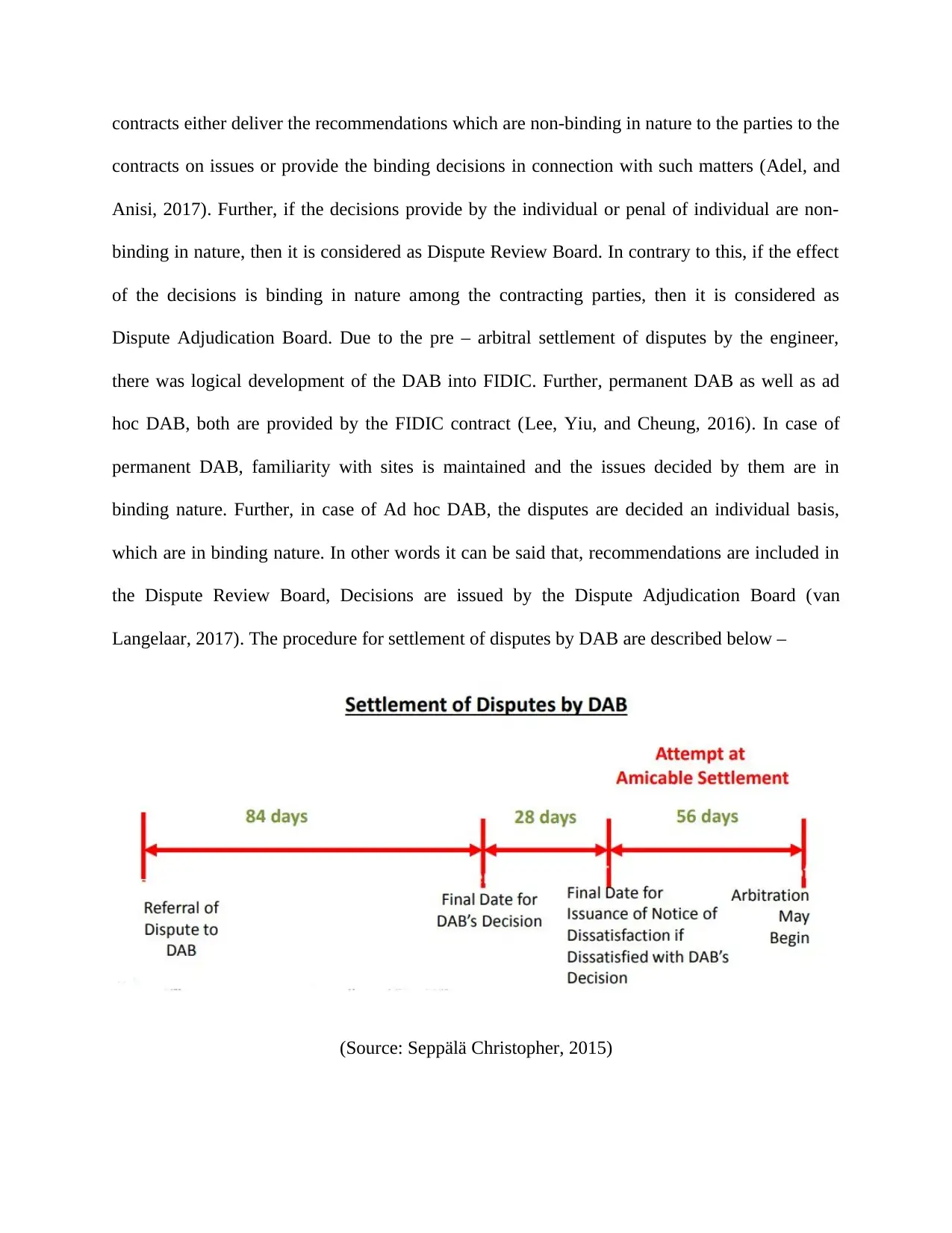
contracts on issues or provide the binding decisions in connection with such matters (Adel, and
Anisi, 2017). Further, if the decisions provide by the individual or penal of individual are non-
binding in nature, then it is considered as Dispute Review Board. In contrary to this, if the effect
of the decisions is binding in nature among the contracting parties, then it is considered as
Dispute Adjudication Board. Due to the pre – arbitral settlement of disputes by the engineer,
there was logical development of the DAB into FIDIC. Further, permanent DAB as well as ad
hoc DAB, both are provided by the FIDIC contract (Lee, Yiu, and Cheung, 2016). In case of
permanent DAB, familiarity with sites is maintained and the issues decided by them are in
binding nature. Further, in case of Ad hoc DAB, the disputes are decided an individual basis,
which are in binding nature. In other words it can be said that, recommendations are included in
the Dispute Review Board, Decisions are issued by the Dispute Adjudication Board (van
Langelaar, 2017). The procedure for settlement of disputes by DAB are described below –
(Source: Seppälä Christopher, 2015)
Paraphrase This Document
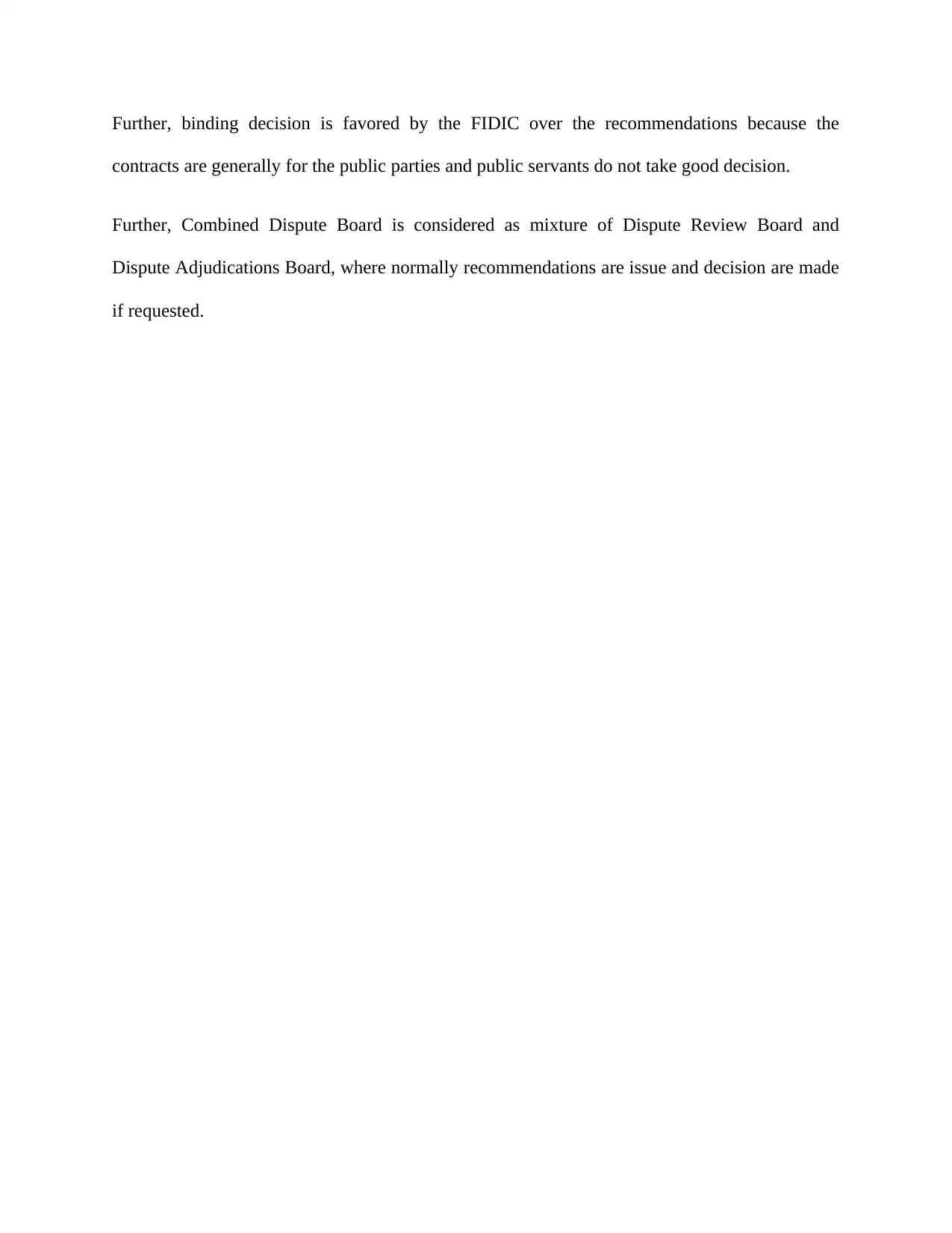
contracts are generally for the public parties and public servants do not take good decision.
Further, Combined Dispute Board is considered as mixture of Dispute Review Board and
Dispute Adjudications Board, where normally recommendations are issue and decision are made
if requested.
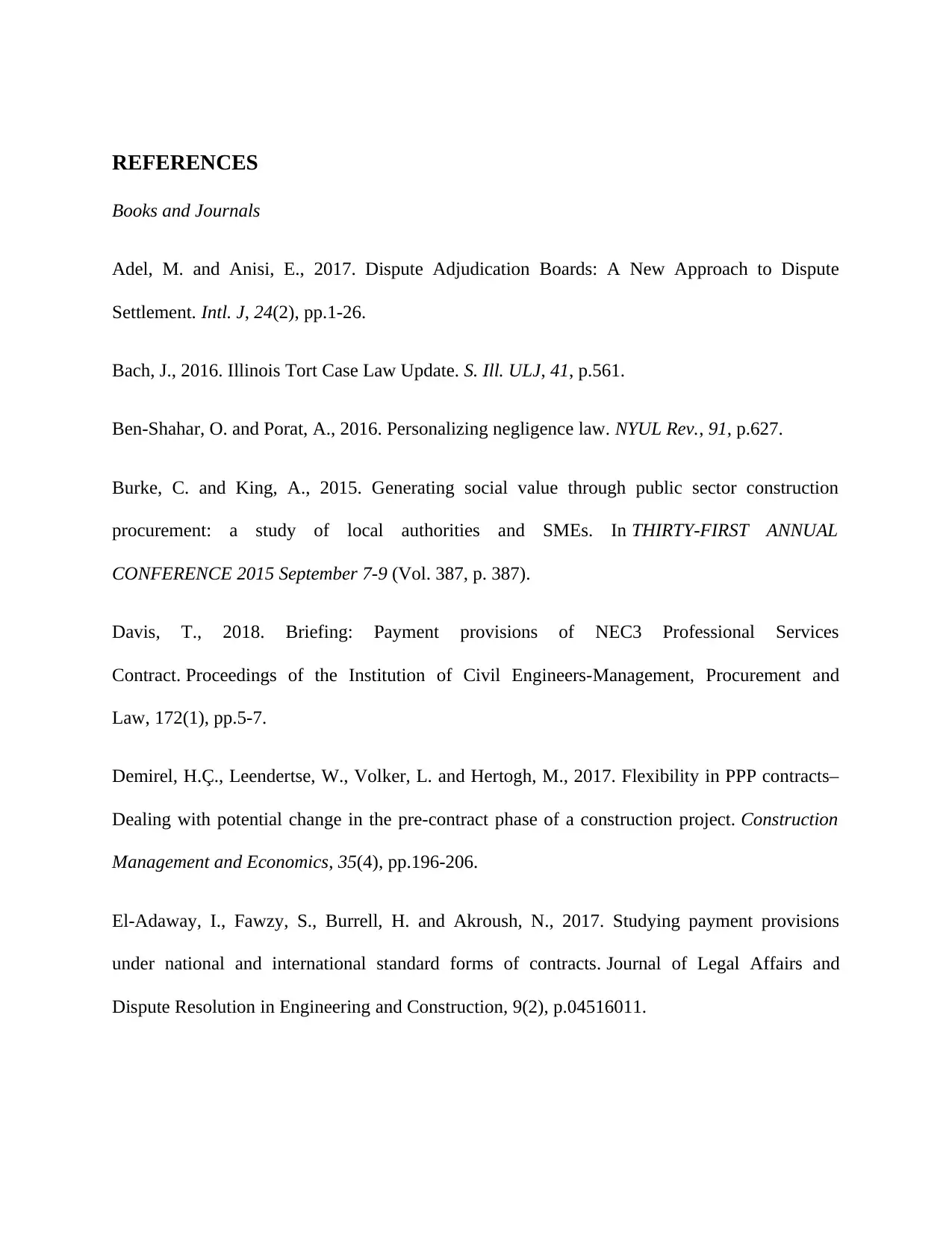
Books and Journals
Adel, M. and Anisi, E., 2017. Dispute Adjudication Boards: A New Approach to Dispute
Settlement. Intl. J, 24(2), pp.1-26.
Bach, J., 2016. Illinois Tort Case Law Update. S. Ill. ULJ, 41, p.561.
Ben-Shahar, O. and Porat, A., 2016. Personalizing negligence law. NYUL Rev., 91, p.627.
Burke, C. and King, A., 2015. Generating social value through public sector construction
procurement: a study of local authorities and SMEs. In THIRTY-FIRST ANNUAL
CONFERENCE 2015 September 7-9 (Vol. 387, p. 387).
Davis, T., 2018. Briefing: Payment provisions of NEC3 Professional Services
Contract. Proceedings of the Institution of Civil Engineers-Management, Procurement and
Law, 172(1), pp.5-7.
Demirel, H.Ç., Leendertse, W., Volker, L. and Hertogh, M., 2017. Flexibility in PPP contracts–
Dealing with potential change in the pre-contract phase of a construction project. Construction
Management and Economics, 35(4), pp.196-206.
El-Adaway, I., Fawzy, S., Burrell, H. and Akroush, N., 2017. Studying payment provisions
under national and international standard forms of contracts. Journal of Legal Affairs and
Dispute Resolution in Engineering and Construction, 9(2), p.04516011.
⊘ This is a preview!⊘
Do you want full access?
Subscribe today to unlock all pages.

Trusted by 1+ million students worldwide

Information Modeling (BIM) Contracts: A Social Network Analysis Approach. KSCE Journal of
Civil Engineering, 23(4), pp.1427-1435.
Fateh, M.A.M. and Mohammad, M.F., 2017. Industrialized Building System (IBS) Provision in
Local and International Standard Form of Contracts. Journal of Construction in Developing
Countries, 22(2), pp.67-80.
Fox, D., 2017. Reproductive Negligence. Colum. L. Rev., 117, p.149.
Franklin, T., 2016. Brown v. Delta Tau Delta: In a Claim of Premises Liability, How Far Should
the Law Court Go to Assign a Duty of Care. Me. L. Rev., 68, p.363.
Friedman, L.M., 2017. Law, lawyers, and popular culture. In Popular Culture and Law (pp. 3-
30). Routledge.
Fulbrook, J., 2017. Outdoor activities, negligence and the law. Routledge.
Gibbs, D.J., Emmitt, S., Lord, W. and Ruikar, K., 2015. BIM and construction contracts–CPC
2013’s approach. Proceedings of the Institution of Civil Engineers–Management, Procurement
and Law, 168(6), pp.285-293.
Gifford, D.G. and Jones, B., 2016. Keeping Cases from Black Juries: An Empirical Analysis of
How Race, Income Inequality, and Regional History Affect Tort Law. Wash. & Lee L. Rev., 73,
p.557.
Griffeth, P.C., Breault, C.R. and Newbern, C.B., 2017. Torts. Mercer Law Review, 68(1), p.1324.
Paraphrase This Document
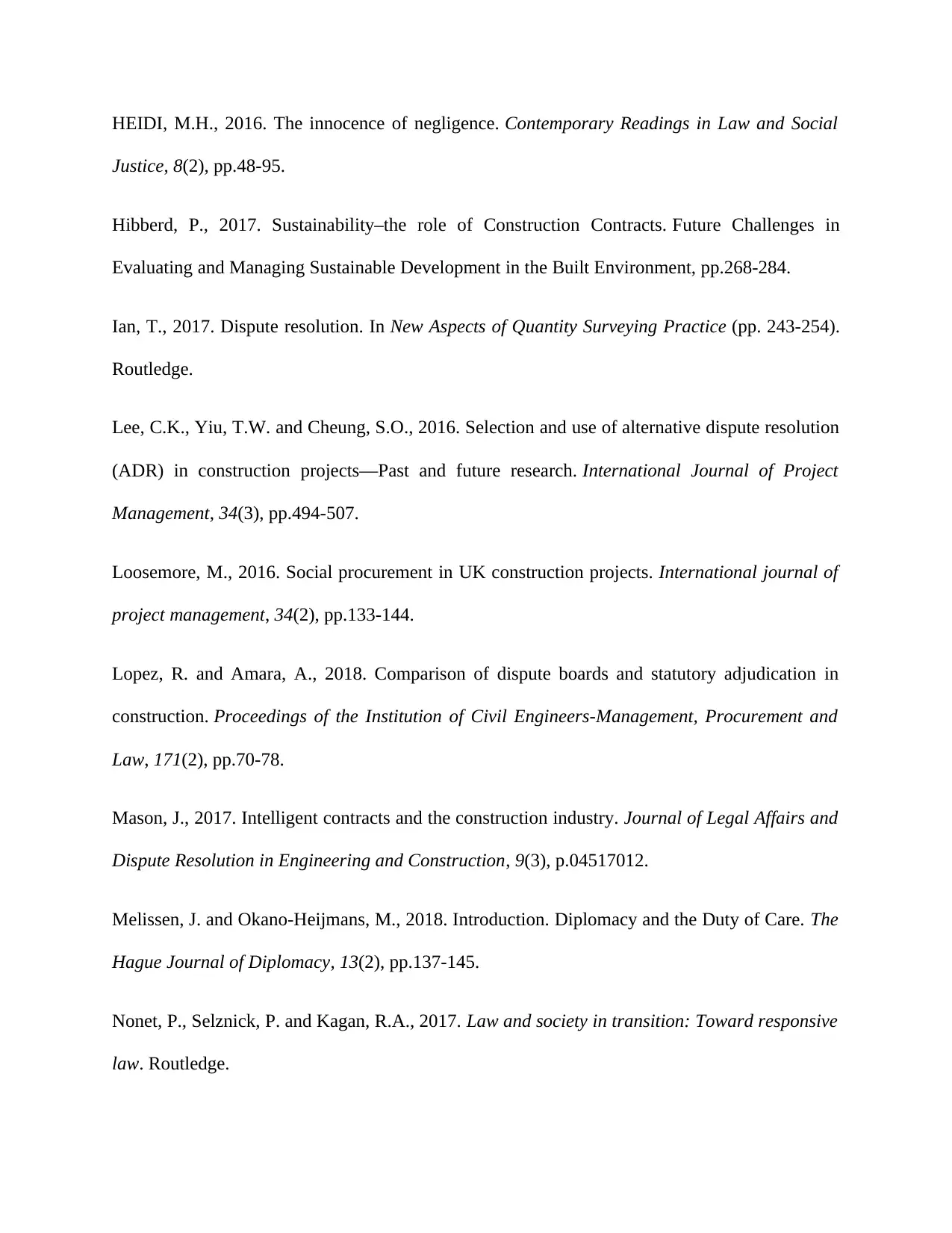
Justice, 8(2), pp.48-95.
Hibberd, P., 2017. Sustainability–the role of Construction Contracts. Future Challenges in
Evaluating and Managing Sustainable Development in the Built Environment, pp.268-284.
Ian, T., 2017. Dispute resolution. In New Aspects of Quantity Surveying Practice (pp. 243-254).
Routledge.
Lee, C.K., Yiu, T.W. and Cheung, S.O., 2016. Selection and use of alternative dispute resolution
(ADR) in construction projects—Past and future research. International Journal of Project
Management, 34(3), pp.494-507.
Loosemore, M., 2016. Social procurement in UK construction projects. International journal of
project management, 34(2), pp.133-144.
Lopez, R. and Amara, A., 2018. Comparison of dispute boards and statutory adjudication in
construction. Proceedings of the Institution of Civil Engineers-Management, Procurement and
Law, 171(2), pp.70-78.
Mason, J., 2017. Intelligent contracts and the construction industry. Journal of Legal Affairs and
Dispute Resolution in Engineering and Construction, 9(3), p.04517012.
Melissen, J. and Okano-Heijmans, M., 2018. Introduction. Diplomacy and the Duty of Care. The
Hague Journal of Diplomacy, 13(2), pp.137-145.
Nonet, P., Selznick, P. and Kagan, R.A., 2017. Law and society in transition: Toward responsive
law. Routledge.
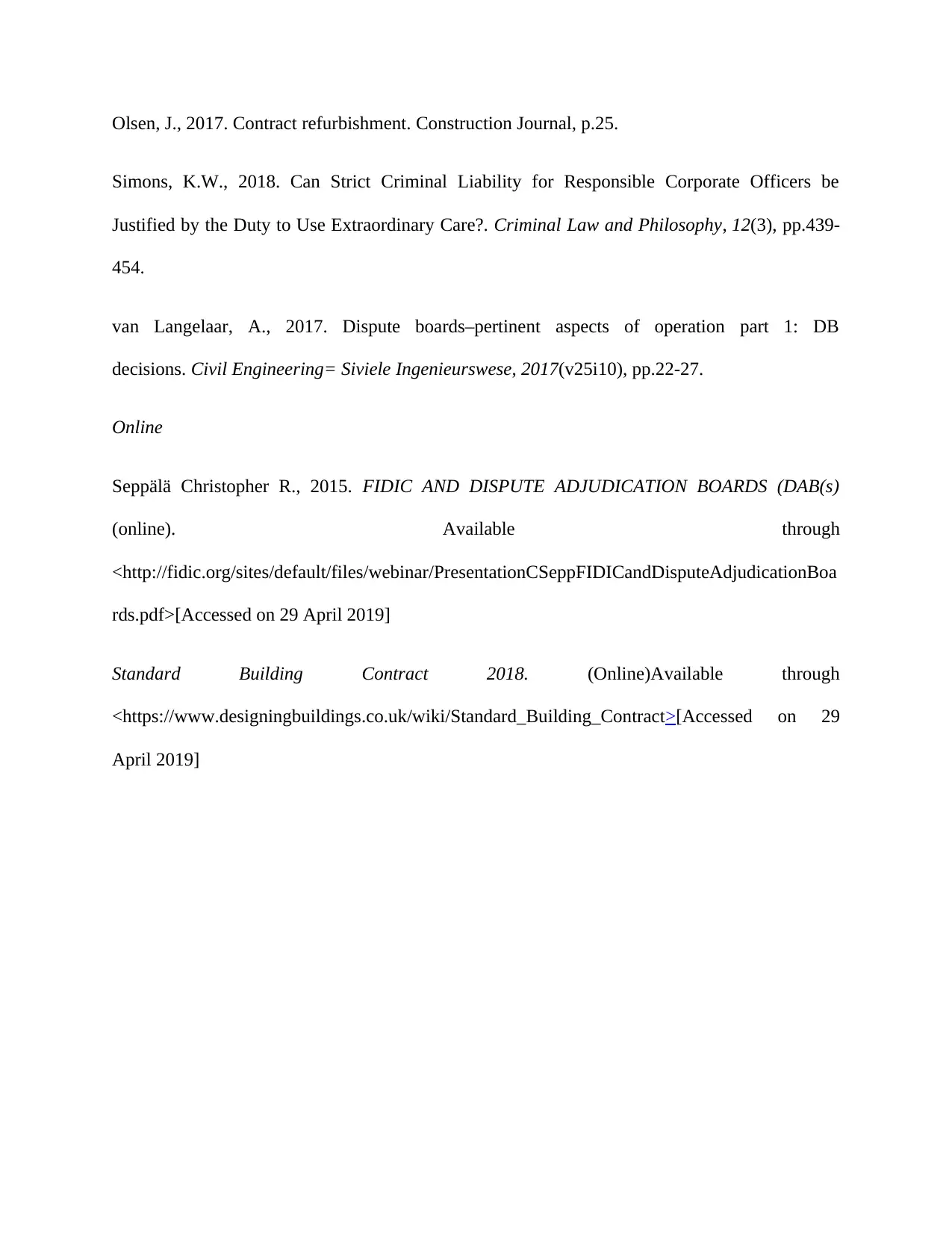
Simons, K.W., 2018. Can Strict Criminal Liability for Responsible Corporate Officers be
Justified by the Duty to Use Extraordinary Care?. Criminal Law and Philosophy, 12(3), pp.439-
454.
van Langelaar, A., 2017. Dispute boards–pertinent aspects of operation part 1: DB
decisions. Civil Engineering= Siviele Ingenieurswese, 2017(v25i10), pp.22-27.
Online
Seppälä Christopher R., 2015. FIDIC AND DISPUTE ADJUDICATION BOARDS (DAB(s)
(online). Available through
<http://fidic.org/sites/default/files/webinar/PresentationCSeppFIDICandDisputeAdjudicationBoa
rds.pdf>[Accessed on 29 April 2019]
Standard Building Contract 2018. (Online)Available through
<https://www.designingbuildings.co.uk/wiki/Standard_Building_Contract>[Accessed on 29
April 2019]
⊘ This is a preview!⊘
Do you want full access?
Subscribe today to unlock all pages.

Trusted by 1+ million students worldwide
Related Documents
Your All-in-One AI-Powered Toolkit for Academic Success.
+13062052269
info@desklib.com
Available 24*7 on WhatsApp / Email
![[object Object]](/_next/static/media/star-bottom.7253800d.svg)
© 2024 | Zucol Services PVT LTD | All rights reserved.




